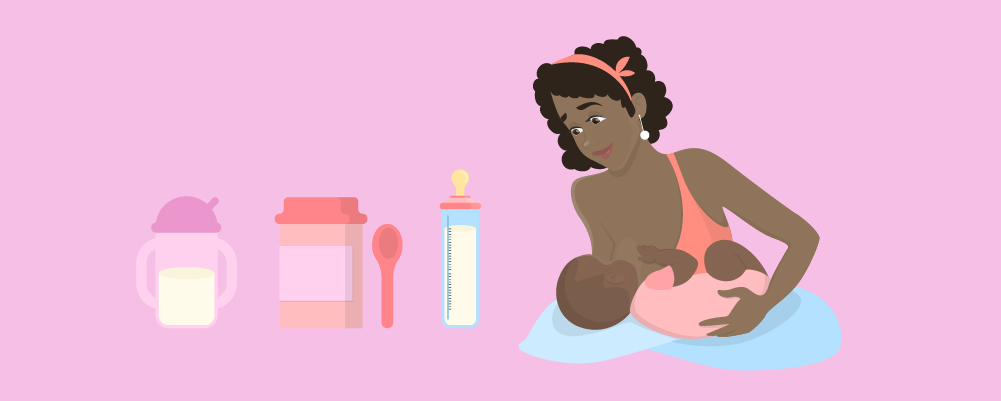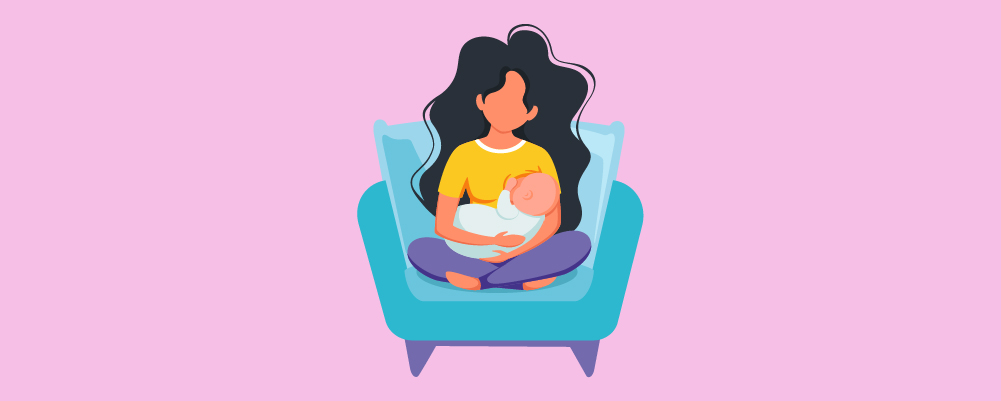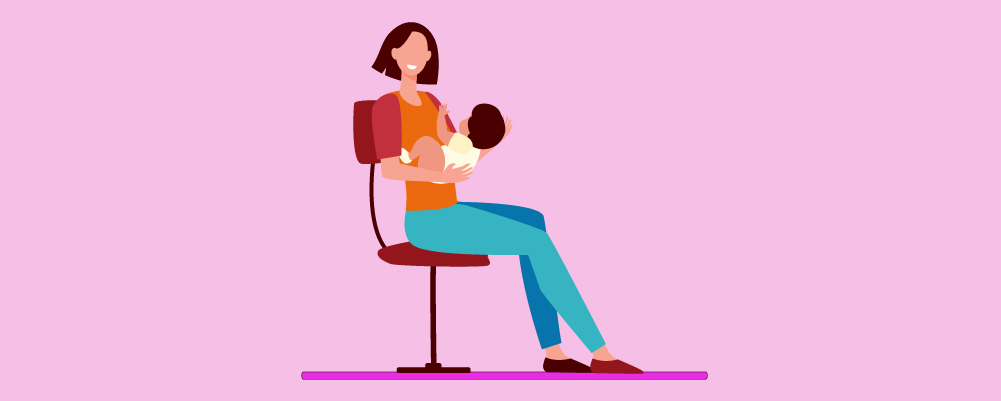When it comes to raising your children, there are few things that aren’t condemned. When you have finally birthed the child which you have carried for almost ten months, breastfeeding suddenly becomes a huge topic of discussion. Half of society likes to proclaim that “breast is best”, whereas others decry breastfeeding as archaic and wonder why anyone would want to breastfeed when formula is so readily available.
This is one of the reasons why many are campaigning for “fed is best” to replace “breast is best”. In order to stop shaming women who cannot breastfeed, do not want to breastfeed, or simply find formula easier. On the other hand, campaigners are also struggling to allow mothers to breastfeed in public. Due to the sexualization of breasts, breastfeeding in public is seen as taboo, when mothers are simply feeding their hungry babies.
So, if you have decided to try breastfeeding, you’re going to need some information to prepare you. Here is everything you need to know about breastfeeding, looking after breastmilk, caring for a breastfeeding baby, and caring for yourself.
How to Breastfeed
View in gallery
Latching On
“Latching on” is the phrase used to describe when your baby is correctly attached to your nipple in order to breastfeed. Your baby will be latched on when their mouth is completely covering your nipple and areola. This is something that is often not known, as many assumed the baby should only be sucking on the nipple. The areola should also be inside their mouths, as this will help them to then massage the milk out through the nipple with their tongue and lips.
With your baby facing you, gently press or tickle their lips with your nipple. They will sometimes open their mouths when you do this. If they do not, squeeze out some colostrum or milk onto their lips. Allow your baby to latch onto your nipple themselves, rather than force the nipple into their mouth. This might be difficult if they are crying but try anyway. Breastfeeding is a natural instinct for babies, they will usually instinctively try to latch on.
When your nipple is in your baby’s mouth, check to see if they are suckling. You might be able to feel this but some people don’t have particularly sensitive nipples, so cannot feel the baby suckling as others might. Check the position of their lips and chin. If they are suckling properly, they will have pouty lips and you will be able to see a rhythmic movement of their jaw and chin. Make sure to check that your baby is actually suckling properly, as they can often accidentally suck their lower lip or just suck or mouth your nipple.
Positions
Having your baby tummy to tummy is one of the easiest positions, there are others that you can try.
- Cradle hold
This is one of the first positions people try. Cradle your baby as you normally would, with their head supported in your elbow and the hand of the same arm supporting their body. Then use the other hand to guide your breast into your baby’s mouth. This is best done sitting down in a chair or couch which is comfortable and supports your back. - Football hold
This hold is, unsurprisingly, similar to how a football player would hold a football as they race toward the touchline. Place the baby’s head to face your nipple with their legs beneath the arm on the same side. To help support your baby’s head, place a pillow beneath them. This will be a useful position if you don’t have much mobility with one of your arms or want to be able to do something else with your other hand. - Crossover hold
This might be a little difficult but if you’re struggling to get your baby to latch, but it’s worth a try. This is very similar to the cradle hold but instead of supporting your baby’s head with the hand on the same side as the feeding breast, you support them with the other. So, if you are feeding them with your left breast, support them with your right hand. This means that your hand will be beneath their head and your arm beneath their body, with their feet toward the crook of your elbow. - Side-Lying
This is a great option for night feeds. As the name suggests, it can be done while lying on your side. Lie down with a pillow beneath your head and place your baby so that they are facing you, with their head in line with your breast. Use one hand to cup your breast and guide it into their mouth. If you find this awkward, place a pillow beneath your baby so that they are higher up and you are not hunching over them. - “Biological Nurturing”
This position is also called the “laid-back” position. Sit on a chair, couch, or on your bed in a reclining position. Make sure that you are fully supported, especially your neck and lower back. Then hold your baby facing your body and place their mouth on your breast. The idea is that your baby will instinctively begin to suckle on your nipple as gravity helps to guide them. You can still cup your breast and guide it if this helps. This can be a difficult and awkward position for some, so don’t be concerned if it doesn’t suit you and your baby.
Burping Baby
Burping your baby is essential after feeding them. There are also several positions for burping your baby.
- Sitting on Your Lap
Sit with your baby on your lap, facing one of your arms with their legs over the side of yours. Support their chest with your arm, making sure to avoid their throat. Allow them to lean forward and gently rub and pat their back. This is best for older babies who are better at supporting themselves. - Over the Shoulder
This is a position that most of us are familiar with. Place a towel over your shoulder and hold your baby so their cheek is resting against it. Support your baby with one hand, then gently rub and pat their back with the other. - Lying Across Your Lap
Lay your baby across your lap, so that their head is pointed toward the side of your legs. Place your arm beneath their chest, avoiding their throat, and gently rub or pat their back. This position is also better for slightly older babies who are better at supporting themselves.
Expressing Breast Milk
View in gallery
Depending on your lifestyle, your job, or even just the weather, you might not be able to feed directly from your breast all the time. Expressing milk is one of the best ways to ensure your baby gets all the nutrients from your breast milk, without feeding directly from your breast. Expressing milk is when you pump milk from your breasts and store it in a container. There are a few different ways to do this:
Expressing breast milk is a great way to ensure your baby is well-fed and that you can get on with other things. This is especially useful if you want or need to return to work or just need a break. But it’s important to make sure that you express properly and safely, as well as store your breast milk in the correct way. It’s also important to remember that your body can sometimes feel a little out of your control, so you can leak milk or need to express at any time. So make sure to get to know your body and support it as best you can.
Storing Breast Milk
Ensuring that breast milk is properly stored is essential, as it can go bad. Breastmilk can be stored at room temperature for around six hours. But, as with other milk, it’s best to keep it cool. Breast milk can be stored in a fridge that is 39F for five days, in a cool box with ice packs for 24 hours, in a fridge’s freezer compartment for two weeks, or in a home freezer for six months.
To store the milk, make sure that it is kept in a sterilized container. These can be plastic bottles or specifically designed plastic milk bags. Make sure to write the date on the containers when storing them so that you know when it was stored and when it will go bad. Try to ensure that the container is air-tight, so it’s best not to store it in a feeding bottle.
Feeding Baby Expressed Milk
Once you have expressed and stored the milk, you will eventually need to use it. If you have frozen your milk, it’s best to defrost it in the refrigerator. This will allow the milk to defrost gradually and won’t risk heating it up too much. Do not defrost the milk in the microwave or ever heat milk up in the microwave. This is because microwaves heat from the inside out, so it can be difficult to tell the temperature of the milk. Even if you pour it onto your skin to test it, it can be boiling hot in the center and you might not realize it.
If your baby doesn’t mind drinking cold milk, then it can be drunk straight from the refrigerator. Pour the milk into a feeding bottle and hold the bottle to their lips. Allow the baby to suckle the nipple top. Always make sure to hold the bottle up so that the milk is completely covering the opening of the bottle. If you don’t, there is a risk that your baby will try to suckle the air inside the bottle, which can cause them to take in air into their stomach.
If your baby doesn’t like cold milk, or you would just prefer to give them warm milk, run the bottle under a warm faucet or place it in hot or warm water. This will gradually and gently warm the milk through.
How Often Should You Breastfeed?
View in gallery
When you first have your baby, it can be difficult to know what they need and when. They will, of course, often communicate with you through crying. So it can be difficult to know if they are hungry, tired, need changing, or just upset and need soothing.
Feeding on demand – when your baby is hungry – is the best way to feed them properly. Just like adults, they have a sense of hunger and when they need feeding. As babies aren’t usually born hungry, it can take a little while for them to get into a feeding rhythm. This should happen around the third day after birth.
But this doesn’t mean that your baby doesn’t need feeding before the third day. Babies should be fed within the first hour of their birth. Then around eight to twelve times over a 24 hour period. You need to initiate the feeding and encourage them to latch. As mentioned above, this can be a little difficult. But you will be shown how to do this by your midwife, doula, or healthcare professional. They will also give you all the information you need for breastfeeding, so make sure you ask about any questions or concerns you have.
ABC of Breastfeeding
View in gallery
Being a new mom can be incredibly overwhelming. Just from the experience of giving birth itself, you will be tired and probably pretty confused and overwhelmed. So remembering everything that you need to know about breastfeeding can seem impossible.
If there is one thing to try to remember, it is the ABCs of breastfeeding. Try to remember these simple things, and most other things will fall into place.
A – Awareness
This means being aware of your baby’s movements and how they signal hunger. Sometimes they will just cry and you have to work out if they’re hungry or not. Other times, they will move their hands to their mouths, make sucking sounds or move their mouth in a sucking motion that imitates suckling, or move their mouths to your breast. It might take a little while, but you will eventually notice the signs and know them instinctively.
B – Be Patient
Patience is important in lots of ways. One way to be patient is to not hurry your baby. They will usually eat for as long as they need to. This is often between ten to twenty minutes on each breast.
But you also need to remember to be patient with yourself. It is natural to find breastfeeding difficult. It can be scary if you are concerned about not being able to feed your child. Remember to ask for help, try different positions, or alternatives to breastfeeding. You have not failed if breastfeeding doesn’t come naturally.
C – Comfort
The more relaxed and comfortable you are, the more easily your milk will likely flow. If you are not relaxed, then your body will be tense and breastfeeding can become difficult. Try to become relaxed and comfortable. Also, try to not become frustrated if breastfeeding feels awkward or difficult, as this will also make you tense up and make things worse. It’s also important for you to be comfortable for your own sake and peace.
Food and Drink to Avoid While Breastfeeding
View in gallery
Everyone knows to avoid drinking when pregnant. Many people also know that there are certain other foods and drinks to avoid when pregnant. But there are a few things that you should also avoid when breastfeeding. Remember that your baby is taking nutrients from your body, so it’s important to try and fill your body with the best nutrients for you and your baby.
Caffeine
If there is one guaranteed experience of parenting a baby, it is sleep deprivation. So hearing that you should avoid caffeine might sound distressing. But it’s definitely a good idea to at least cut down. Try to avoid drinking more than a cup of coffee per day. You should limit your caffeine intake as small amounts can transfer into your bloodstream and into your breastmilk. Caffeine is definitely not suitable for a baby. But, if you’re incredibly tired and feel that nothing other than a cup of coffee will help, one every now and then is okay. We checked out Starbucks to find drinks that are safe for pregnant women.
Alcohol
One thing which a lot of pregnant people look forward to after giving birth is being able to have an alcoholic drink. But it’s best to be avoided. This is because, similarly to caffeine, small amounts of alcohol can be passed into your breastmilk. This is why some mothers “pump and dump”. This means that they will have a few drinks, express their milk with a breast pump, and then throw it away. This allows the mother to enjoy drinking without the risk of passing on the alcohol to their baby.
Fish
Fish is good for both you and your baby but should be eaten in moderation. Try to avoid eating more than two portions of oily fish a week. This is around 280g. This is primarily because of the mercury content in some fish, especially tuna. The mercury can be passed through to the baby via the breastmilk. So it’s best to limit your fish intake, just in case.
Benefits of Breastfeeding
View in gallery
Breastfeeding is one of the best ways to help keep you and your baby healthy. Breastfeeding provides your baby with the nutrients it needs to survive right from the start of life and will help protect them in later life. Here are some of the main benefits of breastfeeding.
- Offers Protection from Infection
- Gives Baby Vitamins and Nutrition
- Reduces Risk of SIDS and Childhood Leukaemia
- Bond With Baby
- Helps Shrink Uterus
- Protect Your Health
- Burns Calories
Giving birth will change your body in a number of ways, some of which breastfeeding can help with. This includes helping to shrink your uterus, lose weight (if you want to!), and help fight infections for both baby and mom. There are a huge range of benefits to breastfeeding. So, if you can, it’s definitely the best first option.
Breastfeeding Challenges
View in gallery
Although breastfeeding has a wide range of benefits, it is, as mentioned above, pretty tricky for a lot of moms. Here are some of the challenges that you might encounter when breastfeeding.
Colic
Colic is when a baby cries for long periods of time with no obvious reason. If your baby cries for more than three hours a day, three days a week and there is no reason behind it, then they very likely have colic.
Babies with colic can be soothed through burping, sitting your baby up and holding them, cradling them, giving them a warm bath, holding them to your chest so they can hear your heartbeat, or rocking. Colic can be incredibly difficult to deal with, so always speak with your doctor, midwife, or healthcare professional if you need help. You may also want to look into formulas that are best for Colic.
Constipation
When you first change your baby’s nappy, you might think that they can never be constipated. But this isn’t the case. Your baby might be constipated if they are pooping fewer than three times a week, have a firm belly, are less hungry, have dry poops, or especially smelly wind and poop.
Constipation can be caused by a change in diet. For example, it is common for babies to become constipated when they first start drinking formula. It can also be caused by dehydration or a lack of fiber.
The best way to help relieve constipation is to ensure your baby is getting enough fluids and fiber. If you bottle-feed your baby, try giving them some water in between feeds. If your baby is eating solid foods, try adding in more fruits and cereals. Apples and prunes are especially good.
Another option is to massage your baby. Lay them on their back and then move their legs as though they were riding a bicycle.
Reflux
Reflux is when a baby brings back up the milk they have just eaten. If this happens often, it can be concerning as your baby might not be getting enough food. If this is the case, speak to your doctor. The most obvious symptom is your baby bringing up their food. Other symptoms include hiccupping and coughing, being grizzly and/or crying after a feed, poor weight gain, frequent ear infections, and sitting up frequently.
Some babies might not be showing that they are bringing up their food, so it’s important to keep an eye out for other symptoms. There is no specific treatment for reflux but try feeding your baby smaller portions more often. If this doesn’t work, medication might be required.
Mastitis
Mastitis is when your nipple becomes inflamed, which can sometimes turn into an infection. This is painful and uncomfortable. Symptoms include red patches on your breasts, a lump or hard area on your breast, and feeling tired or run down with flu-like symptoms.
Mastitis is caused by your milk coming in faster than it is being expelled. This can cause the milk to build up and become backed up. The best way to treat mastitis is to breastfeed or express when you’re unable to feed. Even if you have developed an infection, you can continue breastfeeding as this won’t affect your baby.
Some babies might not be showing that they are bringing up their food, so it’s important to keep an eye out for other symptoms. There is no specific treatment for reflux but try feeding your baby smaller portions more often. If this doesn’t work, medication might be required.
Sore Nipples
Sore nipples are a very common symptom of breastfeeding but this will usually go once you become more used to feeding. A common cause of breastfeeding is your baby not latching properly. So always make sure that they are properly latched on. The best thing to do is to look after your nipples and try to soothe any soreness. If your nipples are dry and cracked, you can use Vaseline and other products that are designed to treat dry skin.
It’s also important to allow your nipples to dry after every feed, although some mothers find that rubbing breast milk on their nipples actually helps relieve soreness. If you can, it’s also a good idea to wear cotton bras without underwriting and avoid using soap on your nipples.
Is Baby Getting Enough Milk?
View in gallery
Knowing when your baby is satiated can be difficult, especially with your first baby. There are several signs to look out for which can tell you if your baby is getting enough milk.
- They stop feeding and move away from the breast by themselves. This usually means they are satisfied and no longer need feeding.
- Their cheeks are full and round, instead of hollow and sharp.
- Their mouth appears wet after feeding.
Going Back to Work
View in gallery
Going back to work is another difficult topic. It is one that is often debated as people consider the impact it can have on the baby. But rarely does the conversation consider whether it is good for the mother. Nor does it seem to consider the potential role of another partner (usually the father) or family members.
You might never want to go back to work and want to spend all of your time with your baby. Or you might be desperate to return to a routine and the company of other grown-ups. Both of these are understandable and valid decisions. If you do choose to return to work, it’s important to consider how you might continue breastfeeding. Here are some things that might help you to continue breastfeeding after you return to work.
- Find Childcare Close to Work
- Negotiate a Flexible Working Pattern
- Experiment with Partial Breastfeeding
- Expressing at Work
When to Stop Breastfeeding
View in gallery
The World Health Organization (WHO) recommends breastfeeding your baby exclusively for the first six months of their life. After this, the choice is yours. If you find breastfeeding difficult or uncomfortable, then you can wean your baby after six months. If you feel bonded to your baby or find breastfeeding easier than carrying around bottle bags and sterilizing and warming up bottles everywhere you go, then you can continue for as long as you deem healthy. Here are some tips on stopping breastfeeding cold turkey.
The reason why babies should be breastfed for the first six months is because of the amazing nutrients in breast milk, but also because they cannot eat solid food. From six months, babies can begin eating other foods. This does not mean that you have to stop at six months, only that you now have more options. You can continue to breastfeed for a whole year or longer. Depending on the preference of you and your baby.
How to Stop Breastfeeding
View in gallery
There is no correct or incorrect way to stop breastfeeding. For some mothers, it simply happens naturally as they begin to feed their babies solid food. The baby becomes more interested in the solid food, so gradually stops asking for the breast. That said, while babies can have solid food from six months, their primary drink should still be breast milk or formula until they are around a year or so old.
The easiest way to stop breastfeeding is to gradually drop feeds. This is known as “weaning”. If you were to stop suddenly, then your baby might become confused as they won’t understand what is happening. Gradually introducing solid food and other drinks and dropping feeds is the easiest option, as it will be less sudden and easier to comprehend as the baby will already be used to some solid foods.
Summary
View in gallery
For some mothers, breastfeeding comes easily and naturally but this is not always the case. If you struggle with breastfeeding and need to try different positions, methods, and take a while to get used to it, then you are absolutely not alone. Some babies and mothers simply cannot get along with breastfeeding, some mothers cannot breastfeed, and some babies have so much difficulty latching that it simply cannot be done.
While breastfeeding does have a huge range of benefits and should be tried, it is not the only way to feed your baby. Fed is best and your baby will be happy and healthy if they are fed with formula. Guilt is an emotion that almost every mother feels, and is often made to feel, but if you are feeding your baby, then you are doing the right thing. And you’re doing a great job.






